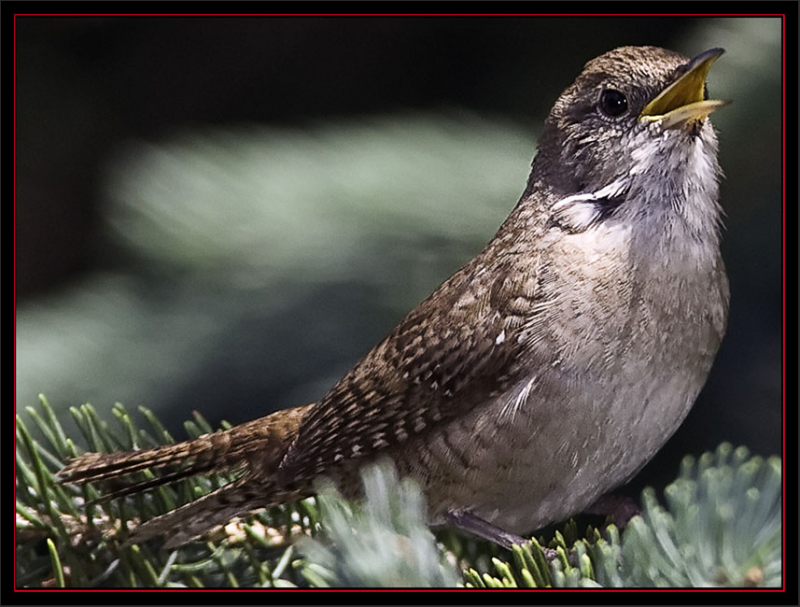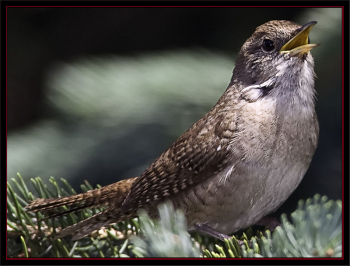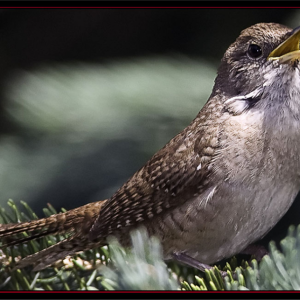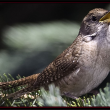House Wrens: Annoyed or Enjoyed?
House wrens — do they inspire joy, or do they annoy? You could say that the song of these tiny, short-tailed, streaky brown birds is “bigger” than a bird this small has a right to. Some have said it’s not the most pleasing, at least when compared to other neighborhood songsters the cardinal, robin, song sparrow, or the warblers. A series of stuttering churrs and trills, the song of the house wren is a few seconds long and is repeated, over and over and over and over, every second or two, sometimes for what seems like hours on end. Like any self-respecting bird, the house wren starts singing that song at or a little before dawn every morning. Here in Maine, in June, if you have a house wren nesting nearby, they might be your alarm clock — set unalterably and continually from 4:30 and 5 a.m. You may be reminded of this fact as you hear the song thousands of times throughout the remainder of the day. Some people who share their property or live in proximity to house wrens find that the brain eventually relegates the sound to background noise. That can even be true of us birders. We have occasionally discovered, when standing in our own yard, that a house wren had been singing for the last few minutes but we only suddenly became aware of it.
House wrens nest in cavities, whether in trees or in the human-made cavities we call bird houses. Which leads us to another house wren behavior some people don’t like: house wrens will sometimes destroy the eggs and toss out the nests of other birds whose nesting place is one that they would like to use. It is amazing that such a small bird could have so much cheekiness and bravado to do this to species that may be two or three times larger. But they do, and the egregiousness is heightened if the evicted nester is a bluebird or other generally favored species—especially since nest boxes are often erected specifically for said bluebird, or chickadee, or swallow.
Maine is at the northern edge of the range of the house wren in North America, so we try to pay attention to where you can find them in the state. The Maine Breeding Bird Atlas project is in the midst of building a new map of exactly where house wrens are (and are not) in the state and how much this has changed since the last atlas was completed a few decades ago. We do know that they are largely absent from much of the northern Maine, at least the heavily wooded parts. They do seem to be a species that is generally increasing and moving north, likely as a result of climate change, so it will be fascinating to see what happens in years to come.
House wrens also have a complicated taxonomy in that various forms occur across the Americas from southern South America north to southern Canada. Some authors have considered the southern form to be a different species from the northern form. To make it harder to untangle, there are many forms that have been variously described as subspecies or separate species that occur on islands, including some specific to particular islands of the Caribbean. Some of these forms are also endangered.
Where do we fall in the “enjoy vs annoy” debate about house wrens? As you may have guessed, we feel fortunate to have house wrens singing away the summer this year in our neighborhood, especially since we hadn’t had them for a number of years until now. Perhaps, if you hear that familiar, if incessant, trill, you are finding joy in it, too!
Jeffrey V. Wells, Ph.D., is a Fellow of the Cornell Lab of Ornithology. Dr. Wells is one of the nation's leading bird experts and conservation biologists and author of “Birder’s Conservation Handbook”. His grandfather, the late John Chase, was a columnist for the Boothbay Register for many years. Allison Childs Wells, formerly of the Cornell Lab of Ornithology, is a senior director at the Natural Resources Council of Maine, a nonprofit membership organization working statewide to protect the nature of Maine. Both are widely published natural history writers and are the authors of the book, “Maine’s Favorite Birds” and “Birds of Aruba, Bonaire, and Curaçao: A Site and Field Guide” from Cornell Press.
Event Date
Address
United States

























